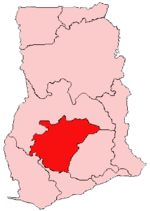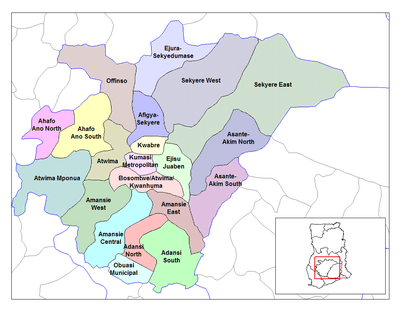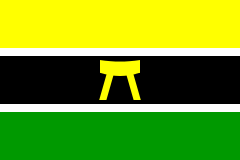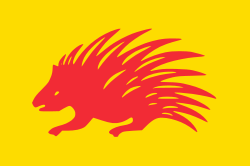Ashanti Region
| Ashanti | |||
|---|---|---|---|
| region | |||
| |||
 Location of Ashanti Region in Ghana .jpg) Map of Ashanti | |||
 Districts of Ashanti | |||
| Country | Ghana | ||
| Capital | Kumasi | ||
| Districts | 27 | ||
| Government | |||
| • Regional Minister | Samuel Sarpong | ||
| Area[1] | |||
| • Total | 24,389 km2 (9,417 sq mi) | ||
| Area rank | Ranked 3rd | ||
| Population (2010 Census)[2] | |||
| • Total | 4,780,380 | ||
| • Rank | Ranked 1st | ||
| • Density | 200/km2 (510/sq mi) | ||
| GDP (PPP) | |||
| • Year | 2013 | ||
| • Per capita | $5,150 | ||
| GDP (Nominal) | |||
| • Year | 2013 | ||
| • Per capita | $2,500 | ||
| Time zone | GMT | ||
| Area code(s) | 032 | ||
| ISO 3166 code | GH-AH | ||
The Ashanti Region is located in south Ghana and third largest of 10 administrative regions, occupying a total land surface of 24,389 km2 (9,417 sq mi) or 10.2 per cent of the total land area of Ghana. In terms of population, however, it is the most populated region with a population of 3,612,950 in 2000, accounting for 19.1 per cent of Ghana’s total population. The Ashanti region and Kingdom of Ashanti and Ashantiland is known for its major gold bar and cocoa production and also harbors the capital city of Kumasi.
Geography
Location and size
The Ashanti region is in Asanteman and centrally located in the middle belt of Ghana. It lies between longitudes 0.15W and 2.25W, and latitudes 5.50N and 7.46N. The region shares boundaries with four of the ten political regions, Brong-Ahafo Region in the north, Eastern region in the east, Central region in the south and Western region in the South west. The region is divided into 27 districts, each headed by a district chief executive.
Tourism
Parks
- Bobiri Forest Butterfly Sanctuary
- Bomfobiri Wildlife Sanctuary
- Digya National Park
- Kogyae Strict Nature Reserve
- Owabi Forest Reserve and Bird Sanctuary
Recreation areas
- Centre for National Culture
Historic sites
- Komfo Anokye Sword
- Manhyia Palace Museum
- Kumasi Fort & Military Museum
- Armed Forces Museum
- The Prempeh II Jubilee Museum
Festivals
Several festivals are celebrated in the region, the major ones being the Akwasidae and Adae Kese. These are religious festivals celebrated by some members of the Akan ethnic group of which the Ashanti belong. The festivals are celebrated to remember past leaders and heroes. Though they are dead, their spirits are believed to be alive and taking interest in the affairs of the living, watching their actions, and consulting with them during the Adae festival.
- Papa Festival
- Kente Festival
- Yaa Asantewaa Festival
- Mmoa Nni Nko Festival
- Nkyidwo Festival
Other Tourist Attractions
- Kejetia Market
- Patakro shrine
- Adinkra cloth printing in Ntonso
Demographics
Population
The center of population of the Ashanti Region is located in the Kumasi Metropolitan District. According to the 2000 census, the region had a population of 3,612,950, making it the most populous region; however, its density (148.1 per square km) is lower than that of Central (162.2/km2) Region.[3] Majority of Ashanti region’s population are Ethnic Akans and citizens by birth (94.2%) with five per cent naturalized Ghanaians. A smaller proportion (5.8%) of the population originate from outside Ashanti and Akanland or Ghana, made up of 3.7 per cent mainly from the five English-speaking countries of ECOWAS and 2.1 per cent from other African countries. The non-African population living in the region is 1.8 per cent of the total population. Akans are the predominant ethnic group in the region, representing 94.2% of citizens by birth. A high proportion (82.9%) of the Akan population is Ashanti.[4]
Transportation
The Ashanti region is served by the Kumasi Airport, which handles domestic flights. Five National highways – N4, N6, N8, N10 and N6 – and a few Regional highways such as the R52 and R106 serve the region.
The N6 connects Kumasi via Kwame Nkrumah Circle and through Nsawam and N4 to Accra. The region is also connected to the Central Region by the N8 and N10, both of which originate from Yemoransa in the Central Region. The N10, however, connects the regional capital of Kumasi.
Education
Senior High Schools
- Osei Kyeretwie Senior High School, Kumasi.
- Agogo State College, Agogo Asante-Akyem.
- Collins Secondary Commercial School, Agogo Asante-Akyem.
- Kumasi Academy, Asokore-Mampong, Kumasi.
- Opoku Ware School, Kumasi.
- Prempeh College, Kumasi.
- Simms Senior High School.
- Kumasi Girls' Senior High School.
- Bekwai SDA Senior High School.
- Oppong Memoral Senior High School.
- St Joseph Senior High School (Ehuren).
- Asanteman School (Real Assas).
- Afia Kobi Ampem Girls (Royal AKAGSHS).
- Anglican Senior High School, kumasi ( kass.edu.gh )
- Jachie-Pramso Senior High School (Formerly MIGHTY JAPASS)
- Beposo Senior High School, Beposo
- Afia Kobi Senior High School, Trabuom
- Komfo Anokye senior High School, Wiamoase
- Agona SDA Senior High School, Agona
- Ejisuman Senior High School, Ejisu
- Simms Senior High School,Fawoade
- Yaa Asantewaa Girls' Senior High School, Tanoso
- T.I. Ahmadiyya Senior High School, Kumasi
- Kumasi Wesley Girls High School
- OBUASI SECONDARY TECHNICAL SCHOOL(O.S.T.S)
Higher education
The Ashanti region has one public university, the Kwame Nkrumah University of Science and Technology and a Polytechnic in Kumasi. In addition, there are a number of private universities and university colleges spread throughout the region.
Universities
- Kwame Nkrumah University of Science and Technology, Kumasi.
- Garden City University College, Kenyasi, Kumasi.
- University of Education, Kumasi Campus, Kumasi.
- National Institute Of Information Technology, Kumasi Campus NIIT.
- Kumasi Polytechnic, K-Poly.
- IPMC, Kumasi Campus
- Akrokerri College of Education
Sports
- Kumasi Asante Kotoko
- Ashanti Gold SC
- King Faisal Babies F.C.
- New Edubiase United
- Main Stadium is Kumasi Sports Stadium
Districts
The political administration of the region is through the local government system. Under this administration system, the region is divided into 27 districts.[5] Each District, Municipal or Metropolitan Area, is administered by a Chief Executive, representing the central government but deriving authority from an Assembly headed by a presiding member elected from among the members themselves.
| Districts in Ashanti Region Region[6] | ||
|---|---|---|
| District | Capital | Population |
| Adansi North | Fomena | 235,680 (2000 census) |
| Adansi South | New Edubiase | 129,325 (2000 census) |
| Afigya-Kwabre | Agona | |
| Ahafo Ano North | Tepa | 71,856 (2000 census) |
| Ahafo Ano South | Mankranso | 133,874 (2000 census) |
| Amansie Central | Bekwai | 219, 508 (2000 census) |
| Amansie West | Manso Nkwanta | 108, 768 (2000 census) |
| Asante Akim North | Konongo | 126, 465 (2000 census) |
| Asante Akim South | Juaso | 96, 885 (2000 census) |
| Atwima Kwanwoma | Foase Kokoben | 234, 759 (2000 census) |
| Atwima Mponua | Nyinahin | |
| Atwima Nwabiagya | Nkawie | |
| Bekwai Municipal | Bekwai | |
| Bosome Freho | Asiwa | |
| Bosomtwe | Kuntenase | 145,524 (2000 census) |
| Ejisu-Juaben Municipal | Ejisu | 124, 179 (2000 census) |
| Ejura/Sekyedumase | Ejura | 81, 119 (2000 census) |
| Kumasi Metropolitan | Kumasi | 1, 171, 311 (2000 census) |
| Kwabre | Mamponteng | 164, 668 (2000 census) |
| Mampong Municipal | Mampong | |
| Obuasi Municipal | Obuasi | |
| Offinso Municipal | Offinso | 138, 190 (2000 census) |
| Offinso North | Akomadan | |
| Sekyere Afram Plains | Kumawu | |
| Sekyere Central | Nsuta | |
| Sekyere East | Effiduase | 157, 378 |
| Sekyere South | Agona Ashanti | 143, 213 |
Famous native citizens
| Famous native citizens of Ashanti | ||
|---|---|---|
| # | Citizen | Settlement |
| 1 | Richmond Boakye | Agogo |
| 2 | Deborah Owusu-Bonsu | Kumasi |
| 3 | Sulley Muntari | Konongo |
| 4 | Sonia Ibrahim | Kumasi |
| 5 | Emmanuel Frimpong | Kumasi |
| 6 | Kofi Annan | Kumasi |
| 7 | John Kufuor | Kumasi |
| 8 | Isaac Vorsah | Kumasi |
| 9 | Juliet Ibrahim | Kumasi |
| 10 | Sam Jonah | Obuasi |
| 11 | Rhian Benson | Kumasi |
| 12 | Samuel Kuffour | Kumasi |
| 13 | Kofi Kingston | Kumasi |
| 14 | Tony Yeboah | Kumasi |
| 15 | Kwadwo Asamoah | Kumasi |
| 16 | Maxwell Konadu | Kumasi |
| 17 | Harrison Afful | Kumasi |
| 18 | Quincy Owusu-Abeyie | Kumasi |
| 19 | Kevin-Prince Boateng | Kumasi |
References
- ↑ "Ashanti Region". Ghanadistricts.com. Retrieved 2010-10-13.
- ↑ "Ashanti Region". Ghanadistricts.com. Retrieved 2010-10-13.
- ↑ Ashanti Region
- ↑ Ashanti Region
- ↑ Ashanti Region
- ↑ Ashanti Region. Geohive.com.
 |
|
 | ||
| |
|
| ||
| ||||
| | ||||
| |
|
|
| ||||||

